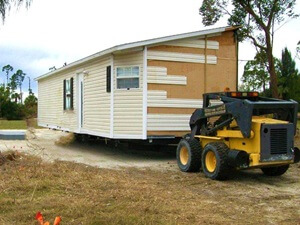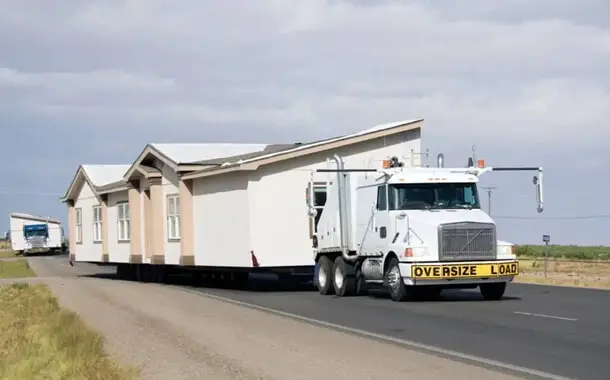How Much Does It Cost to Move a Trailer House?
Last Updated on April 16, 2024
Written by CPA Alec Pow | Content Reviewed by ![]() CFA Alexander Popinker
CFA Alexander Popinker
Moving a mobile home or trailer can be one of the most expensive moves you’ll undertake. Costs typically range from $1,000 to $5,000 for local short-distance relocations up to $10,000 to $20,000 or more for long-distance moves of a few hundred miles.
This in-depth guide covers everything you need to know, including cost breakdowns, price influencing factors, the step-by-step process, tips for choosing services, regulations, and answers to frequently asked questions. Let’s dive into the details of moving a trailer or mobile home.
How Much Does It Cost to Move a Trailer House?
At a high level, these are the main costs that factor into relocating a mobile home:
- Transport and towing fees – The base charge to physically move your trailer via truck and towing equipment. This is usually priced per loaded mile. Expect to pay $1.50 to $3.00+ per mile depending on distance.
- Labor – The moving company will charge labor fees for securing, loading, unloading and setting up the home. Figure $200 to $500 per day for a 2+ person crew.
- Permits – You’ll need to pay your local municipality for permits to move the home and occupy the new lot. Permit costs range from $100 to $500+ depending on the jurisdiction.
- Site preparation – Grading, leveling, clearing debris, and readying the new lot can cost $500 to $1,500 or more.
- Setup and stabilization – Installing blocks, anchors, piers, and supports to stabilize the trailer will run you $800 to $2,000+.
- Utility connections – Hooking up electric, water, sewer, and gas lines typically costs $500 to $1,500 per utility.
- Insurance – Moving insurance and any specialty transit policies for a trailer can cost $250 to $1,000+.
- Miscellaneous – Other small costs like oversize escorts, regulatory fees, skirting, steps, etc. Factor $500 to $1,500 for potential fees.
Preferred Homes MI discusses the cost of moving a manufactured home, highlighting factors like size, type, distance, permits, and inspection costs that influence the overall expense. They mention that moving a manufactured home a short distance may cost around $1,000, while a long-distance move to a new location could exceed $10,000.
MoveBuddha delves into the cost of moving a mobile home, emphasizing that relocating a single-wide trailer within 50 miles using a full-service mobile home mover typically ranges from $3,000 to $9,000.
The cost can vary based on permits, utility connections, setup services, labor, and the home’s characteristics like age, weight, and size. Moving a double-wide or triple-wide home can incur higher costs, with estimates reaching $15,000 or more.
HomeGuide also provides valuable information on the cost of moving a mobile home, stating that the average cost for a single-wide trailer ranges from $1,000 to $8,000, while a double-wide can cost between $2,000 and $15,000.
Factors That Impact the Moving Cost
Several important factors will determine your total moving expenses for relocating a mobile or manufactured home:
Distance of the Move
The further you move your trailer, the more you’ll pay, mainly due to transport costs being directly tied to mileage. For example:
- Short local moves up to 50 miles can cost as little as $2,000 to $4,000 all-in.
- Moving 50 to 150 miles may run $5,000 to $10,000.
- For long-distance relocations over 200+ miles plan for $15,000 to $25,000+.
Permits, insurance, and other fixed costs also increase with greater distances.
Size of the Home
Larger homes cost more to move due to requiring more trucks, labor, setup costs, etc:
- Relocating a single-wide trailer (8′ to 14′ wide) typically costs $3,000 to $8,000.
- Moving a larger double-wide home (16′ to 22′ wide) runs $7,000 to $15,000+ on average.
However, double-wides may cost slightly less per square foot overall.
Time of Year
Peak moving months like summer can be up to 25% more expensive due to high demand. Off-season moves in fall and winter are ideal for savings.
Permitting and Regulations
Each state, county, and city has its own rules on registering, inspecting, taxing, and moving manufactured homes. These regulatory costs can really add up. For example, some states charge oversize load escort fees while others don’t. Understanding the regulations is key to avoiding surprise fees.
Insurance Requirements
Most states require a minimum of $100,000 in liability insurance to perform a mobile home move. Dealing with uninsured or underinsured movers is risky, so check policy limits carefully. Also consider getting supplemental moving insurance through your homeowner’s or renter’s policy for full protection.
You might also like our articles about the cost of living in a trailer park, getting a double-wide trailer, or moving a shed.
Step-by-Step Moving Process
Relocating a mobile or manufactured home is a complex, multi-stage process. Here is a breakdown of how a typical trailer relocation works:
Preparing for the Move
The preparation phase is crucial for a smooth process:
- Research and comply with regulations and permitting requirements, which vary by state. This can take days or weeks.
- Thoroughly inspect the new home site and prepare the grounds and utilities access.
- Obtain necessary moving permits from your home municipality as well as any destinations along the route. These often take 1-2 weeks to process.
- Request quotes from at least 3 reputable, properly licensed, and insured mobile home moving companies. Avoid choosing based on price alone.
- Negotiate a binding moving contract that clearly outlines costs, timeframes, and legal liabilities. Requiring a firm fixed price is advisable to avoid surprise fees.
- Arrange for utilities disconnection at your old site and activation at the new property.
Proper planning is crucial for a seamless trailer relocation. Rushing the process leads to problems down the road.
The Moving Day Process
When moving day arrives, here’s the typical sequence of events:
- The moving crew will arrive with proper equipment including specialized towing vehicles, lifts, and dollies. For larger homes, several trucks and equipment may be needed.
- The home will be secured and raised onto the transport trailer using jacks and lifts.
- Proper oversize load signage and escorts will be used based on state laws for large homes. Road closures may also be required by authorities in some cases.
- The driver will tow your home along the approved route, taking care to watch for low-hanging trees, wires, and other obstructions.
- Police may need to temporarily widen certain intersections by removing light poles. This can add delays, so build buffer time into the schedule.
- Your mover will periodically check the strapping and overall integrity of the home to ensure a safe transit.
- At the destination, the home will be carefully lowered onto the newly prepared site.
Expect the active portion of the moving day to take anywhere from 4-12 hours depending on distance.
Finishing Touches at the New Site
Once your home reaches the destination, final setup steps include:
- Precisely leveling and stabilizing the home on foundation blocks or piers. A laser-level tool ensures proper alignment.
- Anchoring the frame into the ground with auger tie-downs and stabilizer plates. This secures the home against winds and seismic activity per regulations.
- Installing skirting around the base to enclose the space between the ground and floor joists. This improves insulation and pest control.
- Adding stairs, decks, porches, and other external accessories.
- Connecting utilities including electric, water, sewer, and gas lines. Most areas require certified technicians to perform these hookups.
- Performing any necessary inspections by the local municipality before final occupancy permit issuance.
Give yourself a few days after arrival for finishing touches and inspections before moving in.
The Right Mobile Home Moving Company
 Selecting an experienced, properly licensed mover is one of the most important decisions you’ll make. Here are tips for vetting and choosing companies:
Selecting an experienced, properly licensed mover is one of the most important decisions you’ll make. Here are tips for vetting and choosing companies:
- Get written estimates from at least 3 movers; avoid only looking at the cheapest option.
- Verify they are properly licensed with all required operating authorities and insurance.
- Look for companies specializing in mobile home relocations specifically. Avoid generalist movers without manufacturing housing experience.
- Check their safety record and inspection scores. The Federal Motor Carrier Safety Administration provides records of violations.
- Read online customer reviews and talk to previous clients if possible.
- Understand their claims process and dispute resolution policies in case anything goes wrong.
- Get a binding moving contract clearly outlining costs, timeframes, liabilities, and dispute resolution process.
- Inquire about any necessary supplemental insurance to protect your home and belongings.
Doing diligent research protects you from choosing the wrong mover and incurring major headaches.
Rules and Regulations
In addition to costs, navigating the web of regulations around manufactured home relocation can be challenging:
- Permits – Almost all jurisdictions require transport permits, site occupancy permits, and inspections. Road usage fees and escorts may apply for oversized homes.
- Utility connections – Only certified technicians can connect electric, gas lines, septic systems, wells, etc.
- Home registration – States require registering the home and paying sales tax on new purchases. Updated titles and registration are required when moving across state lines.
- Zoning laws – Your home must conform to the new area’s zoning requirements governing size limits, property line setbacks, external aesthetics etc.
- Insurance mandates – Liability minimums often start at $100,000 but increase for larger homes and longer distances. Supplemental hazard coverage is also recommended.
The rules can be frustrating but working with experienced mobile home movers helps simplify the regulatory process. Getting proper local permits and approvals is essential before undertaking a move.
Frequently Asked Questions
Here are answers to some frequently asked questions about moving manufactured housing:
What’s the oldest mobile home that can be moved?
There’s no specific age limit, but homes built before 1976 when modern HUD manufacturing standards took effect may not withstand transport stresses. Very old trailers can develop frame cracks, rust, and other defects. Have an inspector thoroughly evaluate its road-worthiness before attempting a move.
Are trailer homes truly mobile?
Yes – trailer and mobile homes are designed to be transportable to different locations, unlike regular site-built houses. However, you still need to work with professional mobile home movers and obtain permits to relocate one, even for short distances. They are not quite as simply mobile as the name suggests.
What sits underneath a mobile home?
Mobile homes sit on top of a foundation made from concrete piers, piles, blocks or jacks. These spaced supports hold up the weight and keep the structure level. The area in between is open underneath or sometimes enclosed with skirting. The foundation needs to be installed before the home can be anchored and occupied. Proper foundation design is critical.


Leave a Reply
Want to join the discussion?Feel free to contribute!